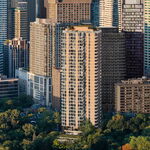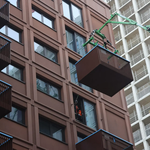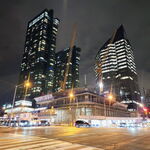I agree, besides reaching Bloor in the west for additional relief (something that can be accomplished with the quicker SmartTrack), there is little benefit of bringing the DRL up Roncesvalles, there is very little ridership there. Reaching Sunnyside is good for the time being. WWLRT could serve Humber Bay.
I see a lot of people pooh-pooh the western leg of the DRL, but at the same time demanding the eastern leg be overbuilt all the way to Steeles (exactly paralleling SmartTrack and the Yonge Line). Part of this comes, I think, from Steve Munro, who has lived and worked his entire life east of the Don Valley and seems to downplay or attack any transit project west of Spadina (e.g. WWLRT, Jane LRT, DRL west, ARL) as unnecessary but east of Yonge (DRL from CBD to his childhood home at Yonge/Eg, WELRT to abandoned industrial sites in the portlands, etc.) as critical.
The fact is that Toronto's center of gravity has always been tilted to the west, along with the GTA as a whole. Missisauga, Oakville, and Brampton have seen disproportionate amounts of growth, and the western section of ontario as a whole benefits from good road connections to the US.
St. George station, although not in the same situation as Yonge/Bloor currently is, will face the same capacity issues as Yonge/Bloor does (especially in the time frame of a DRL actually coming into operation). Between the Vaughn extension, the Finch LRT, and the ECLRT western extension there will soon be enough pressure on St. George station to merit relief. A faster alternative route downtown, besides resulting in time savings for Etobicoke/Missisauga commuters would relieve St. George station, the central section of Bloor-Danforth, and provide small additional relief to Bloor-Yonge.
I doubt that SmartTrack/GO RER will provide any relief from the west because:
1) The transfer connection between Dundas West and GO is awkward, just like how it is on the east side between Main and GO.
2) SmartTrack, once operational, will only be coming every 15 minutes, which doesn't justify the time penalty of transferring
3) Most people's destinations aren't actually at Union Station, so if they continue on to St. George/Yonge-Bloor and transfer they can get off at King/Queen/College/Dundas instead of making an extra connection or walking from Union. The DRL would be closer to the actual CBD
4) GO RER/SmartTrack will probably already be jammed full of passengers from Brampton by the time it hits Bloor, like how the Yonge subway trains are full for anyone south of Eglinton)
5) There is a significant fare premium to transfer to GO, and I doubt that it will completely disappear with SmartTrack (there is a premium to Paris' RER network for example)
The extra two kilometers to go up from Exhibition to Bloor add a lot of value in time-savings for west-end commuters, relief for St. George, and improved access to/from the west. My pet alignment is through Parkside to Keele, which would be shallow enough to be cut and cover and not disrupt any businesses. High Park also offers space for staging of construction material.






